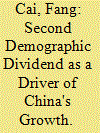| Srl | Item |
| 1 |
ID:
119160


|
|
|
|
|
| Publication |
2013.
|
| Summary/Abstract |
The demographic dividend, that is, the growth of the working age population aged 16 years relative to younger and older age dependents, has often been cited as a crucial component of the accelerated economic growth experienced by disparate countries and regions at different points in time. Generally less emphasized are the ramifications of this process when it occurs in reverse; that is, when the relative size of the working age population begins to shrink. Related to this is the more subtle effect of changes to the age structure of the overall working age population, which can have compounding or offsetting effects in relation to the demographic dividend noted above. This paper explores how these age-related phenomena were instrumental to both the Great Depression and the Great Recession of 2008. We explore how the generational composition of economic actors and the aging of the baby-boom worker may have played a role in provoking these remarkable recessionary periods. The reversal of the demographic dividend and the aging of the working age population are factors now contributing to the propagation of the global economic downturn, as witnessed in the example of Japan over the past half-century. This paper applies the lessons of the Great Depression to offer a forward-looking analysis of the Chinese economy. China is on the precipice of a significant demographic shift whose implications for economic growth are explored.
|
|
|
|
|
|
|
|
|
|
|
|
|
|
|
|
| 2 |
ID:
138046


|
|
|
| 3 |
ID:
122082


|
|
|
| 4 |
ID:
158906


|
|
|
|
|
| Summary/Abstract |
China's reform, opening up and resultant economic growth in the past 40 years have led to the accumulation of an immense array of experiences, which economists are obligated to look into, analyze and theorize upon. In fact, the rich literature in this area has positively assessed and documented China's successful experiences. However, theories that were established in Western countries have been applied as doctrine to judge China's experiences. By adopting an analytical framework unifying historical logic and theoretical logic, the purpose of this paper is to reveal the unique Chinese experience and its relevance to the general laws of economic development. Based on the experiences of and in reference to research findings about China, this paper chronicles the process of reform, opening up and economic growth, and analyzes the nexus between them. The study demystifies how the incentive mechanism, the factor accumulation and allocation system, market development, and macro policy environment reforms have spurred China's economic growth, structural changes and the increase in productivity. The changes in development stage are examined and policy implications for further reform are discussed.
|
|
|
|
|
|
|
|
|
|
|
|
|
|
|
|
| 5 |
ID:
175572


|
|
|
|
|
| Summary/Abstract |
As China's demographic transition enters a new stage, the “first demographic dividend” – the economic advantage resulting from demographic changes in recent decades – is bound to disappear permanently. China's future development will be characterized by an aging population. The “second demographic dividend” refers to new sources of economic growth derived from this later population change. This paper reveals major constraints caused by aging in China, which is characterized by a tendency to grow old before becoming rich. As the population ages, human capital improvement slows, labor force participation declines and consumption power reduces. This paper suggests taking advantage of a population “echo effect” to improve human capital at all ages, to enhance workers’ ability to benefit from employment, and to improve the labor participation rate of the elderly, which in turn would increase the income and social security of the aged. These measures are conducive to future economic growth and to the cultivation of the second demographic dividend.
|
|
|
|
|
|
|
|
|
|
|
|
|
|
|
|